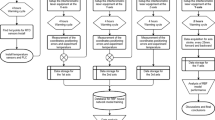Abstract
A novel radial basis function (RBF) neural network-based geometric error compensation method with displacement measurements only is proposed in this paper. The individual geometric error components are formulated mathematically based on laser interferometer calibration with displacement measurements only and modeled using RBF neural network for error compensation in motion controller. Only 4 and 15 displacement measurements are required to identify the error components for XY and XYZ table, respectively. The experiment results on two XY tables illustrate the effectiveness of the proposed method. The overall errors can be reduced significantly after compensation, and different data intervals can be selected to reduce calibration time but maintain a high level of accuracy. The proposed methodology can be extended to other types of precision machine and is more suitable for precision machines requiring a relative low level of accuracy, but fast calibration like those used for acceptance testing and periodic checking.

























Similar content being viewed by others
References
Lee TH, Tan KK, Huang S (2011) Adaptive friction compensation with a dynamical friction model. IEEE/ASME Trans Mechatron 16(1):133–140
Sartori S, Zhang GX (1995) Geometric error measurement and compensation of machines. CIRP Ann Manuf Technol 44(2):599–609
Caskey G, Phillips SD, Borchardt B (1993) Recent results of the NIST national ball plate round robin
Zhu S, Ding G, Qin S, Lei J, Zhuang L, Yan K (2012) Integrated geometric error modeling, identification and compensation of CNC machine tools. Int J Mach Tools Manuf 52(2):24–29
Chen G, Mei X, Li H (2013) Geometric error modeling and compensation for large-scale grinding machine tools with multi-axes. Int J Adv Manuf Technol 69(9):2583–2592
Ding S, Huang X, Yu C, Liu X (2016) Identification of different geometric error models and definitions for the rotary axis of five-axis machine tools. Int J Mach Tools Manuf 100:1–6
Balsamo A, Pedone P, Ricci E, Verdi M (2009) Low-cost interferometric compensation of geometrical errors. CIRP Ann Manuf Technol 58(1):459–462
Chen G, Yuan J, Ni J (2001) A displacement measurement approach for machine geometric error assessment. Int J Mach Tools Manuf 41(1):149–161
Zhang G, Ouyang R, Lu B, Hocken R, Veale R, Donmez A (1988) A displacement method for machine geometry calibration. CIRP Ann Manuf Technol 37(1):515–518
Khoh CJ, Tan KK (2003) Adaptive robust control for servo manipulators. Neural Comput Appl 12(3–4):178–184
Long F, Xiao Y, Chen X, Zhang Z (2013) Disturbance attenuation for nonlinear switched descriptor systems based on neural network. Neural Comput Appl 23(7–8):2211–2219
Sheikhan M, Shahnazi R, Hemmati E (2013) Adaptive active queue management controller for TCP communication networks using PSO–RBF models. Neural Comput Appl 22(5):933–945
Fei J, Ding H, Yang Y (2014) Robust adaptive neural sliding mode control of MEMS triaxial gyroscope with angular velocity estimation. Neural Comput Appl 24(1):201–210
Lin Y, Shen Y (2003) Modelling of five-axis machine tool metrology models using the matrix summation approach. Int J Adv Manuf Technol 21(4):243–248
Lopez J, Artes M (2012) A new methodology for vibration error compensation of optical encoders. Sensors 12(4):4918–4933
Hocken R, Simpson JA, Borchardt B, Lazar J, Reeve C, Stein P (1977) Three dimensional metrology. Ann CIRP 26(2):403–408
Tan KK, Lee TH, Huang S (2007) Precision motion control: design and implementation. Springer, Berlin
Umetsu K, Furutnani R, Osawa S, Takatsuji T, Kurosawa T (2005) Geometric calibration of a coordinate measuring machine using a laser tracking system. Meas Sci Technol 16(12):2466
Ferreira PM, Liu CR, Merchant E (1986) A contribution to the analysis and compensation of the geometric error of a machining center. CIRP Ann Manuf Technol 35(1):259–262
Aguado S, Samper D, Santolaria J, Aguilar JJ (2012) Identification strategy of error parameter in volumetric error compensation of machine tool based on laser tracker measurements. Int J Mach Tools Manuf 53(1):160–169
Fan K, Yang J, Yang L (2014) Unified error model based spatial error compensation for four types of CNC machining center: part II unified model based spatial error compensation. Mech Syst Signal Process 49(1):63–76
Fu G, Fu J, Shen H, Sha J, Xu Y (2016) Numerical solution of simultaneous equations based geometric error compensation for CNC machine tools with workpiece model reconstruction. Int J Adv Manuf Technol 1–14. doi:10.1007/s00170-015-8175-y
Olyaee S, Hamedi S, Dashtban Z (2012) Efficient performance of neural networks for nonlinearity error modeling of three-longitudinal-mode interferometer in nano-metrology system. Precis Eng 36(3):379–387
Yang F, Dong H, Wang Z, Ren W, Alsaadi FE (2016) A new approach to non-fragile state estimation for continuous neural networks with time-delays. Neurocomputing 197:205–211
Yang R, Er PV, Wang Z, Tan KK (2016) An RBF neural network approach towards precision motion system with selective sensor fusion. Neurocomputing 199:31–39
Howlett RJ, Jain LC (2013) Radial basis function networks 2: new advances in design, vol 67. Physica, Heidelberg
Hartman EJ, Keeler JD, Kowalski JM (1990) Layered neural networks with Gaussian hidden units as universal approximations. Neural Comput 2(2):210–215
Bishop CM (1995) Neural networks for pattern recognition. Oxford University Press, Oxford
Acknowledgments
The authors would like to thank to Research Fund for the Taishan Scholar Project of Shandong Province of China.
Author information
Authors and Affiliations
Corresponding author
Rights and permissions
About this article
Cite this article
Yang, R., Tan, K.K., Tay, A. et al. An RBF neural network approach to geometric error compensation with displacement measurements only. Neural Comput & Applic 28, 1235–1248 (2017). https://doi.org/10.1007/s00521-016-2486-2
Received:
Accepted:
Published:
Issue Date:
DOI: https://doi.org/10.1007/s00521-016-2486-2




